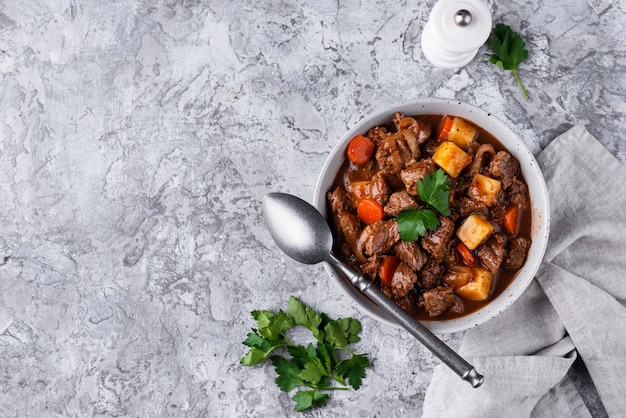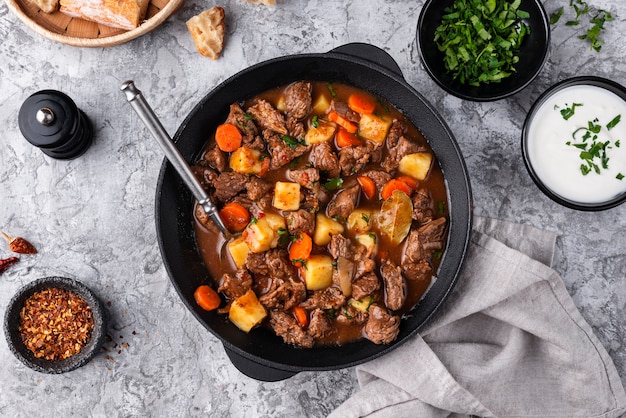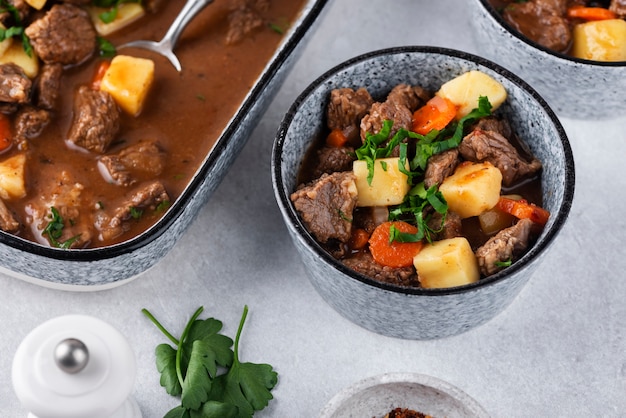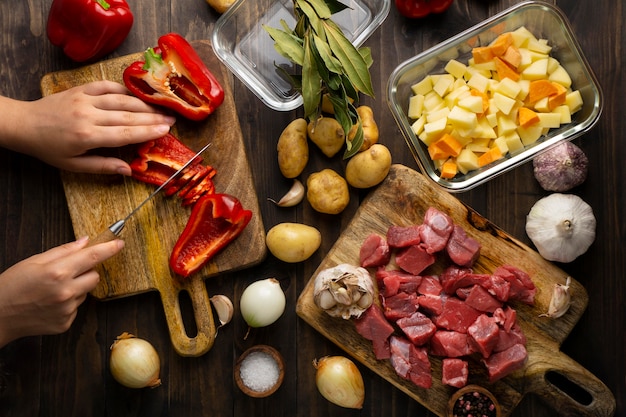Let's talk beef stew, but not just any stew. Forget the watery, bland concoctions you find pre-made in the supermarket. I'm talking about the real deal: a rich, hearty, soul-warming masterpiece. The kind of stew that makes you want to grab a hunk of crusty bread and mop up every last drop. Believe me, achieving that kind of culinary perfection starts with choosing the right cut of beef and mastering the art of slow cooking. So, grab a comfy chair, and let's dive into the secrets of tender and flavorful beef stew meat, a journey I've been on for years, fueled by a passion for this classic dish.
Part 1: My Beefy Journey

My love affair with beef stew began in my childhood. It was a chilly winter evening, and the air was thick with the irresistible aroma of slow-cooked beef, rich gravy, and earthy vegetables wafting from the kitchen. My Mum's famous stew was legendary, and I couldn't wait to dig in. That first bite was pure magic: tender, succulent beef that practically melted in my mouth, a thick, flavourful gravy, and perfectly cooked vegetables with a satisfying bite. It was a meal that embodied comfort, warmth, and pure culinary bliss.
Since then, my passion for beef stew has only grown. But I quickly realised that not all beef cuts are created equal. Some leaner cuts, perfect for grilling, would turn tough and chewy in a stew. I began my quest for the perfect beef stew meat, a journey of experimentation, research, and conversations with seasoned cooks who shared their secrets. Over time, I learned to identify the ideal cuts, mastered the techniques of slow cooking, and discovered the essential ingredients that unlock a stew's true potential.
Part 2: The Anatomy of a Beefy Masterpiece

To understand the best beef stew meat, you need to know a little bit about the anatomy of a cow. The key lies in the connective tissue and fat. These seemingly unassuming elements are the secret to a tender and flavorful stew. During slow cooking, they break down, releasing their flavour and transforming tough cuts into melt-in-your-mouth masterpieces.
2.1: chuck roast: A Classic Choice
Taken from the shoulder of the cow, chuck roast is a true classic for stewing. It's marbled with fat and packed with connective tissue, promising a tender, juicy result after a long braise. It's also a budget-friendly option, making it perfect for weeknight dinners. Think of chuck roast as the reliable friend you can always count on, delivering flavour and tenderness without breaking the bank.
2.2: Brisket: A Rich and Meaty Treasure
Brisket, another tough cut that transforms under slow cooking, is known for its richness and meaty texture. This large cut is perfect for feeding a crowd. Just remember to trim any excess fat before cooking, leaving a thin layer to add flavour and moisture during the slow braising process. Brisket is like a culinary adventure, requiring patience and care, but rewarding you with a deep, satisfying flavour and incredibly tender results.
2.3: short ribs: A Culinary Delicacy
Short ribs, cut from the ribs of the cow, are renowned for their rich flavour and tender texture. They are a touch more expensive than other stew cuts, but the rewards are well worth it. There's nothing quite like biting into a juicy, tender short rib after hours of slow cooking. Short ribs are the ultimate indulgence, a culinary treat that elevates a simple stew into a luxurious meal.
2.4: Oxtail: A Hidden Gem
While oxtail might seem intimidating at first, it's a surprisingly delicious and budget-friendly cut. It's packed with flavour and breaks down beautifully with slow cooking, yielding a rich, flavorful broth. Just be prepared for a slightly longer cooking time. Oxtail is like an adventurous culinary journey, requiring patience and a touch of daring, but delivering a unique and deeply satisfying experience.
Part 3: Picking the Perfect Piece at the Butcher's Counter

Now, let's talk about how to choose the best beef stew meat at the butcher's counter. Don't be shy, ask questions! Let the butcher know what you're planning to cook, and they'll be happy to guide you. Here's what to look for:
3.1: Marbling: The Key to Tenderness and Flavor
The fat streaks within the meat, called marbling, are crucial for a flavorful and tender stew. Look for cuts with good marbling throughout, not just in patches. The more marbling, the more flavour and moisture your stew will have. Think of marbling as the secret ingredient that transforms a tough cut into a culinary masterpiece.
3.2: Colour: A Sign of Freshness
Fresh beef should have a deep red colour, not brown or grey. This indicates that the meat is fresh and hasn't been sitting around for too long. Avoid any meat that has a slimy or sticky surface, as this could be a sign of spoilage.
3.3: Smell: The Ultimate Test
A fresh piece of beef should have a clean, slightly sweet smell. Avoid any meat with a strong, ammonia-like odor. That's a clear sign of spoilage, and definitely something to steer clear of.
Part 4: Prepping for Perfection: Getting Ready to Cook
Once you've found your perfect piece of beef stew meat, it's time to prepare it for cooking. These simple steps can make a big difference in the final flavour and texture:
4.1: Trim the Fat: A Balancing Act
While fat is crucial for flavour, you don't want too much of it. Trim off any excess fat, especially the tough, white bits, which won't render down nicely. However, leave a thin layer of fat on the meat. This will add flavour and help keep it moist during the long cooking process.
4.2: Cut Into Cubes: Ensuring Even Cooking
Cut the meat into uniform cubes, about 1-2 inches in size. This ensures even cooking and allows the flavours to penetrate more evenly. If you're using a bone-in cut like short ribs or oxtail, cut them into individual pieces. Think of these cubes as building blocks for your culinary masterpiece.
4.3: Salt and Pepper: The Foundation of Flavor
Season the beef generously with salt and pepper. This step might seem simple, but it's crucial. Salt helps to draw out moisture and flavour, while pepper adds warmth and complexity. It's the foundation of flavour, setting the stage for a symphony of tastes to unfold.
Part 5: The Art of Slow Cooking: Unveiling Tenderness and Flavor
Now comes the fun part: cooking the beef. This is where patience and a slow, steady approach are essential.
5.1: Searing for Depth: Adding a Rich Crust
Before embarking on the slow cooking journey, give the beef cubes a good sear in a hot pan. This process adds depth of flavour and creates a beautiful crust. To sear, heat a heavy-bottomed pan over high heat and add a tablespoon or two of oil. Once the oil shimmers, add the beef cubes in a single layer, making sure not to overcrowd the pan. Cook for 2-3 minutes per side, until nicely browned. Remove the beef from the pan and set it aside. This process, called browning, is essential for creating a rich and flavorful stew.
5.2: Slow and Steady Wins the Race: Choosing Your Cooking Method
There are several methods for slow cooking beef stew, each with its own advantages:
- dutch oven: This classic cookware is perfect for slow cooking. The thick walls and tight-fitting lid distribute heat evenly and trap moisture, resulting in incredibly tender and flavorful stew. I love using a Dutch oven for my stews. It's like a little cast iron hug for your beef, making it extra tender and flavorful.
- slow cooker: This appliance is incredibly convenient and allows you to cook your stew hands-free. Simply add all your ingredients, set it and forget it! Just be sure to choose a slow cooker that's large enough to accommodate the amount of beef and vegetables you'll be using.
- Oven: You can also slow cook beef stew in the oven. Preheat your oven to 325°F (160°C) and place your beef and vegetables in a Dutch oven or oven-safe pot. Cover tightly and cook for 3-4 hours, or until the beef is fork-tender. This method is great for those who prefer a more hands-off approach.
No matter what method you choose, the key is to cook the beef on low heat for a long period of time. This allows the connective tissue to break down, resulting in incredibly tender meat. And the longer you cook it, the more flavour will develop in the stew. It's a testament to the power of patience in the kitchen.
Part 6: The Flavorful Symphony: Building Your Flavor Profile
A great beef stew is a symphony of flavours. The right combination of vegetables, herbs, and spices can transform a simple stew into something truly special. Here's a guide to building your own flavour profile:
6.1: Vegetables: A Chorus of Textures and Flavors
Choose vegetables that complement the beef and add a range of textures and flavours. Classic choices include carrots, potatoes, onions, celery, and mushrooms. Feel free to get creative and experiment with different combinations, like parsnips, turnips, or even butternut squash. Think of vegetables as the supporting actors in your culinary masterpiece, each adding a unique dimension to the overall flavour profile.
6.2: Herbs and Spices: A Symphony of Aromas
A generous blend of herbs and spices will enhance the flavour of your beef stew and add depth and complexity. Here are some favourites:
- Thyme: A classic herb for beef stew. It adds a warm, earthy flavour that pairs beautifully with beef.
- Rosemary: Offers a slightly peppery and fragrant flavour that complements the richness of the beef.
- Bay Leaf: Adds a subtle, earthy note that enhances the overall complexity of the stew.
- Garlic: A must-have for flavour and aroma. It adds a pungent and savoury note that blends beautifully with the other ingredients.
- Paprika: A versatile spice that adds warmth and depth. Choose sweet paprika for a milder flavour or smoked paprika for a smoky, complex note.
- Black Pepper: A touch of black pepper adds a bit of heat and complexity to the stew.
Think of herbs and spices as the instruments in your symphony of flavours, each adding its own unique sound to create a harmonious and complex melody.
6.3: Liquid Magic: The Essence of Flavor
The liquid you use to cook your beef stew is crucial for flavour and texture. Here are some popular choices:
- beef broth: A classic choice that provides a rich, beefy flavour base. Choose a broth with a good flavour profile and low sodium content.
- Red Wine: Adds a fruity and complex flavour that complements the beef beautifully. Use a dry red wine, like Cabernet Sauvignon or Merlot.
- Beer: A slightly bolder choice that adds a malty and hoppy flavour. Choose a dark beer like stout or porter for a richer flavour.
- Water: A simple but effective option, especially if you're looking for a lighter stew. Just be sure to season the water generously with salt and pepper.
The liquid acts as the conductor in your symphony of flavours, binding all the elements together and creating a harmonious blend.
Part 7: Finishing Touches: Elevating Your Stew to New Heights
As your beef stew simmers away, don't forget about the finishing touches that will elevate it to the next level.
7.1: Thickening the Gravy: Achieving a Luscious Consistency
To create a thick and luscious gravy, you can thicken it with a cornstarch slurry or a roux. A cornstarch slurry is made by whisking together cornstarch and cold water until smooth. A roux is a mixture of equal parts flour and fat, cooked over low heat until it's smooth and golden. Add your chosen thickener to the stew in the final stages of cooking, stirring constantly until the gravy reaches the desired consistency.
7.2: The Finishing Touches: A Symphony of Flavors
Here are some additional tips for making your beef stew truly outstanding:
- Acid: A squeeze of lemon juice or a splash of vinegar can brighten the flavour of your stew and add a touch of tanginess.
- Fresh Herbs: Adding a handful of chopped fresh herbs, like parsley, thyme, or rosemary, in the final minutes of cooking adds a burst of fresh flavour.
- Garnish: A sprinkle of chopped fresh herbs, a dollop of sour cream, or a drizzle of olive oil can add a touch of elegance to your stew.
Think of these finishing touches as the final notes in your symphony, adding a touch of brilliance and finesse to your culinary masterpiece.
Part 8: Serving Up the Goodness: Sharing Your Creation
Finally, it's time to enjoy the fruits of your labour. Here's how to serve your beef stew with panache:
8.1: The Perfect Pairing: Complementary Sides
Beef stew is a comforting and satisfying dish, and it pairs well with a variety of sides. Here are some of my favourites:
- Crusty Bread: A classic choice for mopping up every last drop of gravy.
- mashed potatoes: Creamy and comforting, mashed potatoes are the perfect complement to a hearty stew.
- Rice: A simple and versatile side that won't overpower the flavours of the stew.
- Green Salad: A fresh and crisp salad provides a refreshing contrast to the richness of the stew.
8.2: Presentation Matters: A Feast for the Eyes
Don't underestimate the power of presentation. Even a simple stew can look elegant and inviting when served properly. Here are a few tips:
- Use a beautiful serving bowl: A rustic ceramic bowl or a classic enamel pot will add a touch of charm to your stew.
- Garnish with fresh herbs: A sprinkle of chopped parsley, thyme, or rosemary will add a touch of freshness and colour.
- Serve with a dollop of sour cream: A dollop of sour cream will add a touch of richness and tanginess to the stew.
- Use a rustic wooden spoon: A rustic wooden spoon will add a touch of warmth and authenticity to your presentation.
Part 9: The Art of Leftovers: Reheating and Enjoying More
Let's be honest, you're probably going to have leftovers. And that's a good thing! Beef stew is even better the next day. Here's how to store and reheat your stew:
9.1: Storing Your Stew: Keeping It Fresh and Flavorful
Once the stew has cooled completely, transfer it to an airtight container and store it in the refrigerator for up to 3 days. You can also freeze your stew for up to 3 months. Just thaw it overnight in the refrigerator before reheating.
9.2: Reheating Your Stew: Bringing Back the Warmth
There are a few ways to reheat your stew:
- Stovetop: Heat the stew gently over low heat until it's steaming hot. Stir occasionally to prevent scorching.
- Oven: Preheat the oven to 325°F (160°C). Transfer the stew to an oven-safe pot and cover it tightly with a lid. Bake for 30 minutes, or until heated through.
- Microwave: Microwave the stew in a microwave-safe container, in 30-second intervals, stirring in between, until heated through.
Part 10: FAQs: Answering Your Questions
Here are some frequently asked questions about beef stew:
10.1: How long should I cook beef stew for?
The cooking time for beef stew varies depending on the cut of meat and the method you use. Generally, you should cook it for at least 3 hours, or until the beef is fork-tender. You can always cook it for longer, but it's important to check the beef for tenderness every hour or so. If it's still tough, continue cooking it for another hour or two.
10.2: Can I use frozen beef for stew?
You can use frozen beef for stew, but you'll need to thaw it completely before cooking. It's best to thaw the beef in the refrigerator overnight, as this will ensure that it thaws evenly. You can also thaw it in cold water, but make sure to change the water every 30 minutes to keep it cold. Once the beef is thawed, pat it dry with paper towels and proceed with the recipe as usual.
10.3: Can I add vegetables to the stew after the beef is cooked?
Yes, you can add vegetables to the stew after the beef is cooked. However, it's important to note that some vegetables, like carrots and potatoes, will need to cook longer than others, like mushrooms and onions. Add the vegetables that need to cook the longest, like carrots and potatoes, in the last hour of cooking. Then add the vegetables that need to cook for a shorter time, like mushrooms and onions, in the final 30 minutes of cooking.
10.4: What can I do if my stew is too thick?
If your stew is too thick, you can thin it out by adding a little bit of water, broth, or wine. Just stir the liquid in until the stew reaches your desired consistency.
10.5: What can I do if my stew is too thin?
If your stew is too thin, you can thicken it by adding a cornstarch slurry or a roux. Just whisk together cornstarch and cold water, or flour and butter, and add it to the stew in the final stages of cooking. Stir constantly until the gravy reaches the desired consistency.
Everyone is watching

Perfect Rice Every Time: The Ultimate Guide to Cooking Rice
Cooking TipsAs a self-proclaimed foodie, I've always been a bit obsessed with rice. It's the foundation of countless cuisi...

Ultimate Guide to Cooking the Perfect Thanksgiving Turkey
Cooking TipsThanksgiving. Just the word conjures up images of overflowing tables laden with delicious food, the scent of r...

The Ultimate Guide to Cooking Asparagus: Tips, Techniques, and Recipes
Cooking TipsAsparagus. The mere mention of this spring delicacy conjures up images of vibrant green spears, crisp and burs...

Can You Cook Spaghetti with Gasoline? (The Shocking Truth)
Cooking TipsWe've all seen those crazy internet trends. You know, the ones that make you wonder, "Did someone actually try...

Chorizo and Eggs Recipe: The Ultimate Guide
Cooking TipsRight, let’s talk about chorizo and eggs. You know, that classic Spanish dish that's always a winner. It's th...
